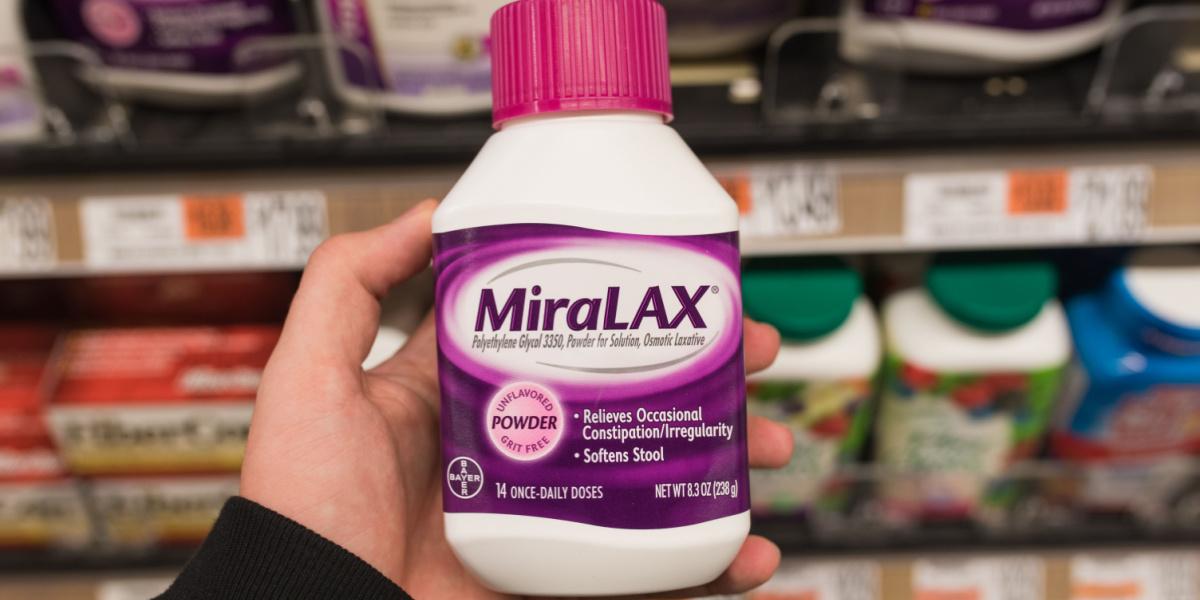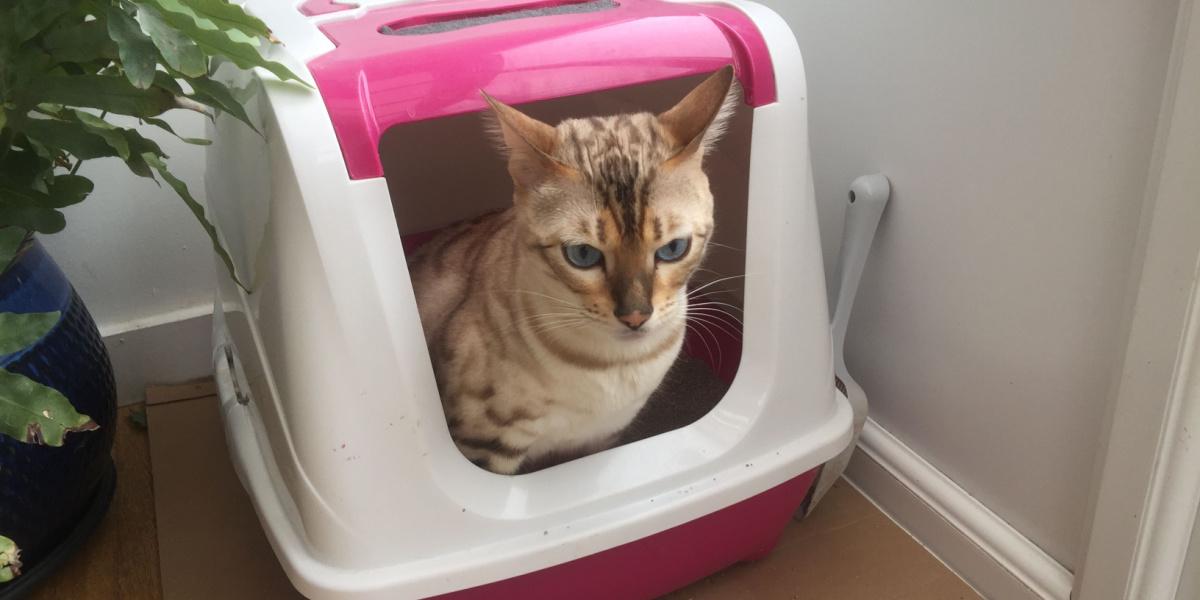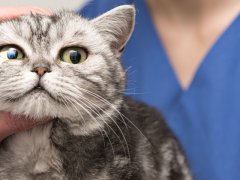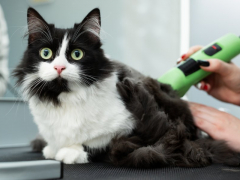
Miralax is a human medication often used for the treatment of constipation in cats. It comes in a tasteless, powder form, which is easy to give to cats and is readily available over the counter.
In this article, learn how Miralax works, the dosage and how to administer this to your cat, along with some common side effects.
Miralax for Cats Overview

About Miralax for Cats
Before we start discussing the use of Miralax in cats, we should know a little bit about Miralax. What is it? Miralax is a common over-the-counter medication used for the short-term treatment of constipation in humans. It contains the active ingredient polyethylene glycol 3350 (PEG 3350) and is classed as an osmotic laxative.
Through the process of osmosis, these laxatives draw water into the intestines and retain it there. As a result, the intestines swell with water and this softens the impacted, hard, dry feces stuck in the intestines. In this way, it acts as a stool softener.
Increased water in the intestines also helps to increase hydration and gut motility (prokinetic), which prevents further constipation. These methods of action will help to produce bowel movements in mild-moderate cases of constipation.
As with humans, Miralax is used for the same purpose in cats to treat constipation. Constipation is a common issue in cats, particular in older cats.
Common underlying causes of constipation in cats include diet change, kidney disease, fur ingestion, medications, or pain (e.g., arthritis or joint issues). Your vet will need to investigate the underlying cause of your cat’s constipation to remove the causing factor if possible and to treat it.
Miralax provides a gentle and easy way to treat your cat if they’re suffering from constipation. The tasteless powder is easy to administer and is readily available in stores. It might relieve constipation and avoid your cat needing more intrusive procedures, such as an enema. Always use Miralax under the advice and recommendation of your veterinarian.
Dose for Cats
Miralax is a human medication. Therefore, there is no official Miralax dosage. I recommend discussing the proper dosage with your veterinarian. They know your cat’s case and medical history the best and are in a better position to advise on the dosage for them. The dosage of Miralax might change based on your cat’s age and underlying health conditions, and the severity of their constipation.
However, a general guideline for the dose in cats is to administer one-quarter teaspoon once to twice daily per cat.
This is a rough guideline for the dosage of Miralax, but as I’ve mentioned, I strongly recommend discussing this with your veterinarian first. Constipation can be a very serious condition and you need to get your vet’s advice first before attempting to treat this at home. This medication won’t be suitable for every case of constipation.
How To Administer Miralax to Cats

Because Miralax is a tasteless powder, it can easily be mixed into wet cat food.
Luckily for cat owners, Miralax comes in a tasteless powdered form. This makes it easier to administer to cats compared to other medications. Ensure that your cat is well hydrated prior to taking Miralax. Provide plenty of water bowls and water fountains to encourage drinking. To give your cat Miralax, simply mix their dose (based on your vet’s recommendation) into some of their favorite wet food.
Pick a wet food that they really like and mix the powder well to disguise it. Click here for some tips on the best food to hide medication in.
Also Read: Best Cat Food For Constipation
Side Effects of Miralax for Cats
Miralax is generally a very safe medication to give to your cat, under the recommendation and advice of your vet. Side effects of this drug are minimal, but there are a few to consider.
As Miralax is an osmotic laxative, it draws water into the intestines. This might cause dehydration in the body, particularly in cats that have underlying conditions, such as kidney disease, or cats that are unwell and already dehydrated.
For this reason, Miralax should only be used if your cat is suffering from mild constipation and if your vet has advised it. Cats that are suffering from severe constipation are/or are very unwell will likely need veterinary treatment, which might include intravenous fluid therapy, x-rays to check for gastrointestinal obstruction, an enema to relieve the obstipation, and medications (e.g., cisapride). Severe constipation might cause an irreversible enlargement of the colon, called megacolon, which needs urgent veterinary care.
Laxatives have the ability to cause diarrhea or flatulence, particularly if too much is given. If this occurs, contact your veterinarian as they might need to prescribe a special diet, fiber, or medication to treat this. Use Miralax with care in cats that tend to have sensitive tummies, and keep a close eye on their litter box if they’re using Miralax.
Overdose and Emergencies
Miralax is a safe, over-the-counter medication and issues with overdoses are rare. In most cases, giving too much Miralax to your cat might cause diarrhea and gas. However, overdoses are possible with any drug and if you have any concern that your cat has overdosed, call your emergency veterinarian right away. You can also call the ASPCA Animal Poison Control Center (1-888-426-4435) or Pet Poison Helpline (1-855-764-7661) for more information.
Potential Drug Interactions With Miralax
Miralax is a human drug and has been shown to be safe to use in the majority of cases, with potentially fewer side effects than other laxatives. According to human data, the drugs below are usually avoided with Miralax use in people unless advised otherwise by their doctor:
- Bisacodyl
- Licorice
- Senna
- Sodium picosulfate
In veterinary medicine, potential drug interactions with Miralax aren’t well known, but it is a relatively safe medication to use. Always discuss Miralax with your veterinarian before giving it to your cat. This is particularly important if your cat has any underlying health conditions or is on medication.
Your vet will assess your cat’s individual case and see if it’s appropriate to use this medication. They will check if it interacts with any other medication your cat might already be on (e.g., for diabetes or hyperthyroidism).
How To Store Miralax
Store Miralax in a child-proof container, away from extreme heat, moisture sunlight, or cold. Avoid freezing temperatures and keep it out of reach of children.
Don’t use medication that is out of date—discard it.
Final Thoughts

Miralax can be used under the guidance of your veterinarian to relieve constipation in most cats.
Miralax is a human medication that can be used to treat mild to moderate cases of constipation in cats. It’s relatively safe with few side effects and is easy to give to cats as it comes in a tasteless powder form.
Cats should pass feces in their litter box within eight to 12 hours after Miralax medication. Be cautious giving it to cats that might be dehydrated or suffering from kidney disease. Always seek the advice of your veterinarian before giving Miralax to your cat.
Frequently Asked Questions
Is Miralax safe for cats?
Yes, Miralax is a relatively safe and easy-to-administer medication for cats to treat constipation. It’s readily available over the counter and comes in a tasteless powder form. Discuss the use of Miralax with your vet before using it for your cat.
What if I miss a dose of Miralax?
Miralax is a safe drug used to treat constipation. It can be given once or twice daily depending on your vet’s advice. If you miss a dose and your cat still has signs of constipation, call your vet for advice. They might advise you to give a dose of Miralax.
How long can cats take Miralax?
Miralax is used short-term for treatment of constipation. It might be used for anything from a few days duration to a few weeks.
How long does it take for Miralax to work in cats?
Miralax usually works within eight to 12 hours in cats. Feces should be produced within 24 hours.
Should cats take Miralax with food?
Yes, Miralax should be administered to your cat in wet food. Ensure that your cat has plenty of water to prevent dehydration.
 Fact checked by
Fact checked by








How to give Mira-lax to cat that wont eat.Can it be dissolved in water and given orally? Have tried chicken soup an wet food but he just walks away.
Hi Richard,
Thanks for your question. Yes, Miralax can be dissolved in a small amount of water and given orally. We have some guidelines here on how to give liquid medicaiton successfully; https://cats.com/how-to-give-cats-liquid-medicine. I hope that works, let us know if you’re having any problems. All the best, Aisling
Use a dropper or syringe. Tilt head up and get it in the side of mouth. Squeeze
How will Miralax affect cats with slightly high kidney values?
Hi Jessica, this is a good question to ask your veterinarian! They know your cat’s current health status best and can give you a better idea how Miralax might affect them.